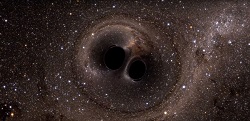Decrypting the gravitational waves of binary black hole systems
Whilst Albert Einstein had already taught us that gravitational waves – ripples of gravity caused by the motion of matter – regularly wash over the Earth to stretch and squeeze the space around us, it was only recently that scientists became able to detect them. Actually, the last time they did was on 28 September 2017, when gravitational waves from colliding back holes were detected for the fourth time in history. ‘Each detection has taught us new and sometimes surprising things about the universe,’ says Niels Warburton, a Research Fellow at University College Dublin (UCD) who got to spend two years at the Massachusetts Institute of Technology (MIT) to advance this new field of research. With his AWE (Accurate Waveforms for Extreme/Intermediate-mass-ratio-inspirals) project, Warburton aimed to set the stage for the European Space Agency’s Laser Interferometer Space Antenna (LISA) – a future space-based gravitational wave detector. Unlike Earth-based detectors, where seismic noise drowns out signals at low frequencies, this detector will be able to measure the waves coming from small mass-ratio systems. ‘One source for these waves is so-called Extreme-mass-ratio-inspirals (EMRIs) where a stellar mass compact object (such as a very dense star or a black hole) is in orbit around a million solar mass black hole. These systems will emit gravitational waves for months or years, but extracting the signal from the noisy datastream requires very accurate models of the incoming waves. The AWE project further developed these crucial models in preparation for the LISA mission,’ Adrian Ottewill, project host and Professor of Mathematical Physics at UCD, explains. To do so, Warburton applied black hole perturbation theory, which he further developed. ‘By combining my own expertise with that of my two host groups, and collaborators, I have published seven papers during my fellowship, with a few more in preparation for publication,’ he says. Of these seven publications, five have progressed the modelling of gravitational waves from extreme mass-ratio binaries as outlined in the original project proposal. The other two papers were initially unplanned for, but of high importance nonetheless: ‘Shortly after starting at MIT, a colleague who I had met a few times at conferences during my PhD walked into my office. Quickly we realised that we had a complementary set of skills which allowed us to make quick progress studying the gravitational wave emission from the inspiral of a compact object into a rapidly rotating massive black hole,’ Warburton recalls. There is a maximum rate at which any given black hole can spin, and black holes that rotate at or very near this rate exhibit some strange new physics. With their work, Warburton and his colleagues demonstrated that the associated gravitational waves have a very distinctive signature – a ‘song’ which, if detected, would immediately signal the existence of one of these unusually fast rotating black holes in nature. Their second paper on this topic, which was entitled ‘Inspiral into Gargantua’ in reference to Christopher Nolan’s movie Interstellar, attracted attention from media outlets such as Space.com and Science News. Warburton is confident that the necessary physics to model extreme mass ratio inspirals are now known, and he hopes that, at some point, his work will contribute to the community’s future capacity to detect and measure them. In the meantime, he intends to continue modelling their gravitational waves under a Royal Society – Science Foundation Ireland University Research Fellowship. He is also leading the creation of an open-source software toolkit to share expertise within and beyond the community. ‘This will allow less researcher time being spent coding and more time spent doing physics,’ he says.
Keywords
AWE, gravitational wave, radiation, black hole, LISA, MIT, detector, EMRIs, Interstellar



